
“If you know the enemy and know yourself, you need not fear the result of a hundred battles. If you know yourself but not the enemy, for every victory gained you will also suffer a defeat. If you know neither the enemy nor yourself, you will succumb in every battle.”
Sun Tzu, The Art of War
Gonzalo Lira, the well-known Chilean-American YouTube personality, has been in the news lately. A former “lifestyle” coach, Lira re-branded himself as a geopolitical commentator in the leadup to the Russian invasion of Ukraine, providing gripping first-hand observations—often critical of the Ukrainian government and contradictory of the Ukrainian narrative—that were posted on YouTube. As his popularity grew, his social media footprint expanded, with his Twitter and Telegram accounts garnering tens of thousands of followers, and his YouTube videos garnering hundreds of thousands of views and subscribers.
Gonzalo Lira was arrested by the SBU, or Ukrainian intelligence service, on April 15, 2022, and released five days later. Lira has been circumspect about both the arrest and the conditions of his release—he blithely calls it his “missing week.” Lira does acknowledge that his computers and phone were seized by Ukrainian authorities, and that he was released under conditions of “house arrest,” implying some sort of continued monitoring and control of his activities by the SBU. Nonetheless, he was able to gain access to a computer, set up a new email account, and immediately begin posting information critical of the Ukrainian government.
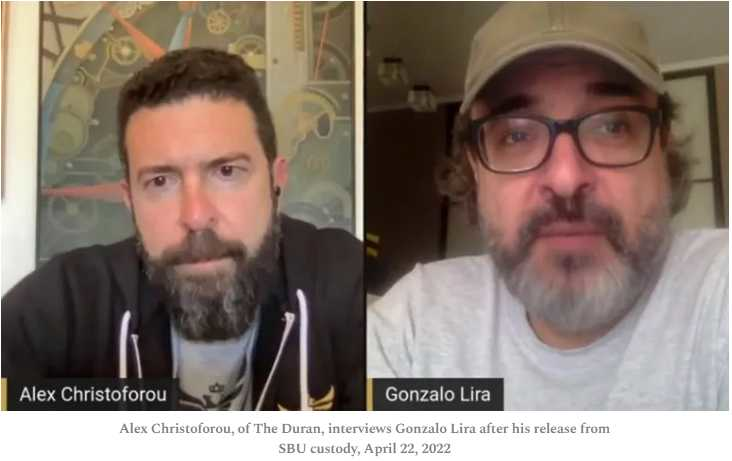
There is only one logical explanation for this chain of events. Gonzalo Lira was arrested by the SBU for crimes he himself admits gets people arrested, tortured, and murdered. He is released five days later—unharmed—and immediately allowed to resume the exact same activity that led to arrest in the first place, only this time on a computer and email account controlled by the SBU.
This is a classic “catch and release” scenario, with Gonzalo Lira playing the role of “police confidential informant”—someone who provides information in exchange for lenient treatment. There literally is no other plausible explanation for what happened other than this.
And yet controversy swirls around the saga surrounding Lira’s arrest and release, as well as his subsequent actions, including his re-arrest in May 2023, his re-release on July 6, and a series of bizarre videos and tweets made by Gonzalo on July 31, released while he waited at the Ukrainian-Hungarian border, awaiting his attempt to “escape” Ukrainian custody, all the while broadcasting his intent for all the world—and the SBU—to see. According to charging documents published by the Kharkov prosecutor overseeing Lira’s case, the former lifestyle coach failed in his attempt, and is once more in the custody of the SBU awaiting trial.
Many people, including those with whom Lira had interacted with and befriended over the course of the past two years, have rallied in his support, taking umbrage—often extreme—at my contention that Lira has been, ever since his arrest in April 2022, an asset of the SBU.
Under normal circumstances, I might make common cause with these people, granting Lira the benefit of the doubt and arguing for his release and subsequent deportation from Ukraine, only addressing the anomalies and inconsistencies in his narrative once he is safely outside of Ukraine.
But these are not normal circumstances.
We are at war.
This applies to everyone reading these words, and everyone who doesn’t. The fact that a person neither accepts that he or she is a participant in this conflict, nor recognizes its existence, does not matter.
We are at war.
This conflict does not involve tanks, artillery, aircraft, bombs, bullets, drones, or bayonets.
It is a war of words, of ideas.
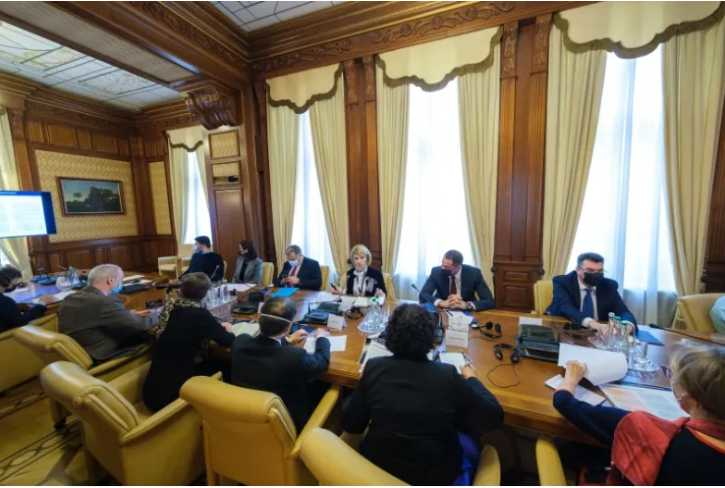
It is an information war, a battle of competing Russian and Ukrainian narratives fought on a global scale. The stakes are high; as Andrii Shapovalov, the acting head of the Ukrainian Center for Countering Disinformation (CCD)—one of the frontline organizations involved in this war—recently noted in an address, “For them [Russia], as for us, this is a matter of life and death.”
Shapovalov’s words were spoken at a gathering of the National Cluster on Information Resistance, convened in Kiev on July 3, 2023. The National Cluster on Information Resistance is a group of experts and organizations that work together to counter disinformation and cyber threats in Ukraine, funded by the US Civil Research and Development Fund (Global), a private entity created by the US Congress whose presence in Ukraine was underwritten and supervised by the US Defense Threat Reduction Agency (DTRA).
Bluntly stated, if you are a US citizen who holds a position counter to the official US government/Ukrainian narrative regarding the Russian-Ukrainian conflict, you are being treated as a hostile combatant in the information war that has sprung up around this conflict, regardless of your constitutionally protected right to free speech.
And if you’re not American, you’re free game.
Just in case that point isn’t driven home strong enough, consider the following: The CCD, with the backing of the United States, has published a blacklist of persons—including many notable American citizens—of persons it has labeled as “information terrorists.” According to the CCD, it’s mission, carried out in conjunction with Ukraine’s National Security and Defense Council, is twofold. First, to combat information terrorism, and second, to coordinate this effort with international “partners.”
The CCD defines “information terrorism” as “a Crime against Humanity committed by means of instruments affecting the consciousness.” In short, anyone who exercises his or her right to free speech can be prosecuted as a “terrorist” in the full meaning of that term.
To drive that point home even more, the United States—Ukraine’s leading partner in this information war—kills terrorists preemptively, void of any notion of due process.
The CCD wants to mainstream this mindset on a global basis. “Having joined forces with the National Security and Defense Council of Ukraine and its international partners,” the CCD has declared, it “is taking the initiative to establish this term in international practice,” calling on the international community to “unite in the face of information terrorism.”
In this regard, the CDD makes four demands. First, that Russia be declared an “infoterrorist state,” and that “infoterrorism” must be equated with “actual terrorism,” requiring “appropriate measures to counter it.” Second, that anyone associated in any way with “infoterror” be treated as an “information terrorist.” This definition is all-inclusive—editors, writers, presenters, cameramen, bloggers, etc.
In short, anyone who is involved in the production of any information that runs counter to the Ukrainian narrative regarding the war with Russia is an “infoterrorist.” Third, the financing of “infoterrorism,” both “explicit” and “implicit,” should be banned by “both international and domestic law,” and those who are involved in such financing should be treated as “accomplices to information terrorists.” And finally, any individual, company, public organization, or legal entity which is involved in “infoterrorism” should be subjected to sanctions, using the US list of “State Sponsors of Terrorism” as a model.
Anyone who has ever uttered or written a word that runs counter to the official Ukrainian narrative is, in the mind of Ukraine, an “infoterrorist.”
Ukraine is at war with “infoterrorists.”
As such, those practitioners of free speech who run afoul of Ukraine’s expansive definition of “infoterrorism” are combatants in this conflict, whether you want to be or not. And in war, the individual doesn’t matter. People are mere tools, to be deployed as needed, used, and discarded when no longer useful.
Chronologically, Lira’s arrest followed on the heels of the CCD’s publication of its mission statement regarding “infoterrorism.” There can be no doubt that Gonzalo Lira fell into the category of “infoterrorism” as far as Ukraine was concerned, as did anyone who collaborated with him.
This is a critical point that must be understood by anyone following Lira’s saga—in the eyes of the Ukrainians, he is an enemy combatant, not an individual with rights. He is a terrorist. Enemy combatants/terrorists are either eliminated or turned into a tool to be used to further the fight against “infoterrorists.”
When Gonzalo Lira was released by the SBU in April 2022, he was not the person he was when he had been arrested. That person was neutralized in Ukraine’s war on “infoterrorism.” Gonzalo Lira’s every move was, and is, controlled by the SBU to assist them in their larger information war against other “infoterrorists.”
If the many people who interacted with Gonzalo Lira, both before and after his April 2022 arrest, do not recognize this reality, then they are playing directly into the hands of the Ukrainian security services, because Gonzalo Lira is a Ukrainian weapon being used as part of a larger information operation being waged against everyone in the alternative media universe who produces content Ukraine might consider running counter to its goals and objectives in its conflict with Russia.
I don’t approach the topic of information warfare, or its derivative activity, information operations, lightly. In my time as an intelligence professional, both with the US Marine Corps and, later, with the United Nations, I was personally involved in information manipulation operations managed by US and UK intelligence services. One involved a joint CIA-CNN/Time collaboration, “The Inspector’s Story,” to produce a documentary which, according to the presenter, CNN’s own Bernard Shaw, used “the inspectors’ own stories told through interviews, documents, videotape and surveillance photographs” to “help explain why the United States and Britain threaten to bomb Iraq if inspections are not allowed to continue unimpeded.”
The timing of the release of the CNN/Time documentary was critical—I was scheduled to lead an inspection team into Iraq in the first week of March 1998 which was designed to provoke Iraq into blocking our work. The US government had deployed extensive military forces into the Persian Gulf and was prepared to use any evidence of Iraqi noncompliance to justify a military strike on Iraq. As Shaw noted, the documentary was designed to prepare an American audience for the need for military action against Iraq.
The collaboration between UNSCOM, the CIA, and CNN/Time wasn’t the only example of information operations designed to influence public opinion. The British government was concerned about the effectiveness of the Iraqi-Russian-French collaboration on shaping an anti-UNSCOM narrative and was keen on flipping the script back to a story line which emphasized Iraqi non-compliance with its disarmament obligation. In the Fall of 1997, I was approached by MI-6 regarding an information operation they were running known as “Operation MASS APPEAL.” MI-6 informed me that they had “connectivity” with highly-placed editors in major newspapers around the world in nations which had shown a proclivity for being swayed by the Iraqi-Russian-French story line.
What MI-6 proposed was for UNSCOM to provide it with intelligence reports we had gathered over the years from various sources which had not been of sufficient quality to “weaponize” into an on-site inspection. These reports were languishing in my safe until which time additional corroboration could be found. The problem was, most of these reports were dated, and even if corroboration could be had, we couldn’t justify an inspection on the grounds that the information lacked currency.
After getting approval from the UNSCOM Executive Chairman, Richard Butler, I passed onto MI-6 several reports which were then processed by MI-6 into “leads” that were leaked to newspapers in eastern Europe and South Asia, where they were turned into news reports that the British government could then use to bolster its case that Iraq was noncompliant with its disarmament obligation. I met with two MI-6 officers in London in June 1998 where we discussed expanding “Operation MASS APPEAL.” However, my resignation from UNSCOM in August 1998 brought this collaboration to an end.
Information warfare, and its derivative, information operations, are an ever-present reality in warfare. The Ukrainians, through the work of the CCD and it’s SBU-run cousin, the so-called “Myrotvorets kill list,” have taken the war on ideas to a whole new level. However, they are not without significant help from both the United States, which provides funding, training, and operational assistance, and the United Kingdom.
Jeremy Fleming, the Director of GCHQ, the British communications spy agency, has acknowledged that there is significant cooperation between his organization and their Ukrainian counterparts regarding information warfare. While neither Fleming nor the Ukrainians have discussed the details of this cooperation, leaked documents from the trove of material released by NSA whistleblower Edward Snowden in 2013 provide critical insight into how GCHQ and, by extension, Ukraine approaches information operations in the digital age, and how someone like Gonzalo Lira could factor into such plans.
Within GCHQ is a special unit known as the Joint Threat Research Intelligence Group, or JTRIG. Within the JTRIG is a more specialized team known as the Human Science Operations Cell, or HSOC. One of the mission statements of the JTRIG is to use “online techniques” to “make something happen in the real world.” This is done through the conduct of targeted information operations designed to influence and/or disrupt the target, something known in the “business” as “effect operations.”
The HSOC conducts active overt internet operations, including online human intelligence collection and effect operations. In the case of Ukraine, the aim of the HSOC and/or its Ukrainian counterpart team in the SBU would be to disrupt the dissemination of information deemed to be pro-Russian propaganda and/or disinformation, to discredit websites hosting such information along with the individuals and/or groups using them, to conduct online human intelligence collection, and to host pro-Russian sites in order to enable the collection of signals intelligence data.
The techniques used by HSOC and their Ukrainian counterparts could include the uploading of YouTube videos containing persuasive messages; establishing online aliases with Facebook, Telegram and Twitter accounts, blogs and forum memberships for conducting human intelligence or encouraging discussion on specific issues; establishing online aliases/personalities who support other aliases; sending spoof e-mails and text messages from a fake person or mimicking a real person; providing spoof online resources such as magazines and books that provide inaccurate information; providing online access to uncensored material; sending instant messages to specific individuals giving them instructions for accessing uncensored websites; and contacting host websites asking them to remove material and/or deplatform/demonetize a targeted individual or group.
Such operations are not “spur of the moment” affairs, but rather involve detailed planning which incorporates human behavioral science. HSOC in particular incorporates the so-called “Hofstede Dimensions” developed by Dutch psychologist Geert Hofstede, which employs cross-cultural ideas of “collectivism” and/or “group think” to influence individuals and/or groups through psychological conditioning and manipulation, into every aspect of its operations.
A critical aspect of employing “Hofstede Dimensions” to their full effect is the ability to develop a detailed behavioral model of the targeted groups and individuals. One of the most effective ways of achieving this is to have an operative insert an alias into a targeted group and/or community, HSOC has demonstrated the ability to carry out the following intelligence collection objectives:
1) Count the number and/or location of views (e.g., for YouTube video) or hits to a website to see if people have accessed the message;
2) Check online and/or collect SIGINT to see if a message has been attended to, understood, accepted, remembered, and changed behavior (e.g., people have spread the message and communicate support for it, people lack trust in the discredited individual/group/regime, people are delayed or deterred from an activity or interaction);
3) Count the number and significance of friends that an alias has, people who have joined the Facebook group, Telegram channel, people who have responded to a blog or post;
4) Analyze the content of communication between a potential source of online human intelligence and the alias to see if he/she is providing useful intelligence;
5) Count the number of times a potential source of online HUMINT initiates communication with the alias;
6) Check online and/or collect SIGINT to see if people have accessed uncensored material that has been made available to them;
7) Check online to see if hosts who have been asked to delete material have done so;
8) Count the number of websites taken down;
9) Check if an individual or group does allow their site to be hosted (unknowingly) by HSOC or Ukrainian intelligence.
Of course, another way of achieving the same objective would be to have someone on the inside operating in a similar role. This would be the ideal operational purpose behind the SBU using Gonzalo Lira as a controlled asset.
One of the documents released by Edward Snowden was a slide presentation entitled “The Art of Deception: Training for Online Covert Operations.” Here the JTRIG openly talks about building so-called “cyber magicians” who “conjure with information” through formal training intended to produce “accredited computer network operators” (ACNO)—modern day information warriors. For those who question the scope and scale of potential information operations that can conceivably be conducted against unwitting targets, the JTRIG training document provides three slides which, when viewed in sequence, demonstrate how “cyber magicians” such as those who would oversee the weaponization of Gonzalo Lira conceive their operational space.

The first slide lists the three “key skill strands” that define the work of an ACNO—Online Human Intelligence, Influence and Information Operations, and Disruption and Computer Network Attacks. Under each skill strand, the slide lists the so-called “magic” techniques and experiments that are used by the operators in their work. Online human intelligence focuses on individual, group, and global collection sets. The influence and information operations focus on four “effects” types: psychology, deception, performance, and media. For disruption and computer network attack activities, an ACNO will emphasize professionalism, elegance, creativity, and intuition.
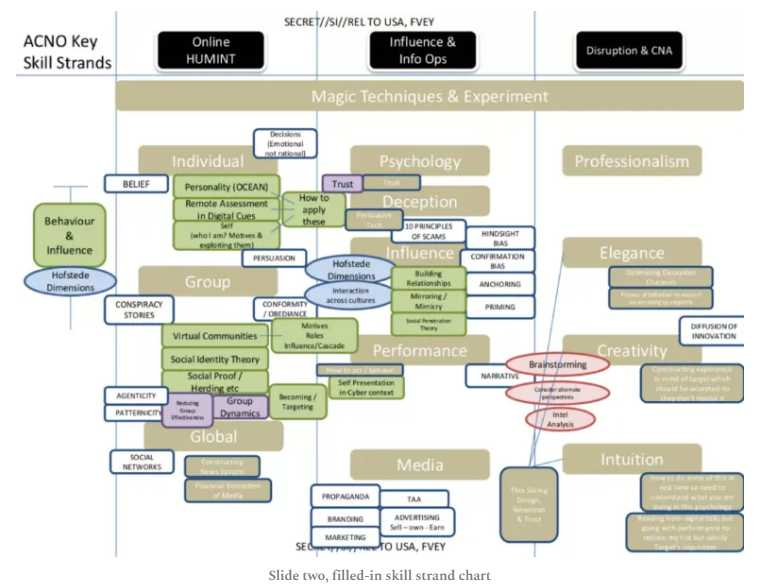
The second slide begins to populate the skill strands with actions done to develop the skill into something that relates to an actual discernable activity and objective. Note the role played by “Hofstede Dimensions” in developing skill strands that deal with human behavior. This approach should impress anyone who is dismissive of the value of having a trusted agent operating on the inside of any targeted group, or able to interact with a targeted individual. Gonzalo Lira would have been an invaluable resource in facilitating access to the kinds of information and insights being developed by the involved ACNOs.
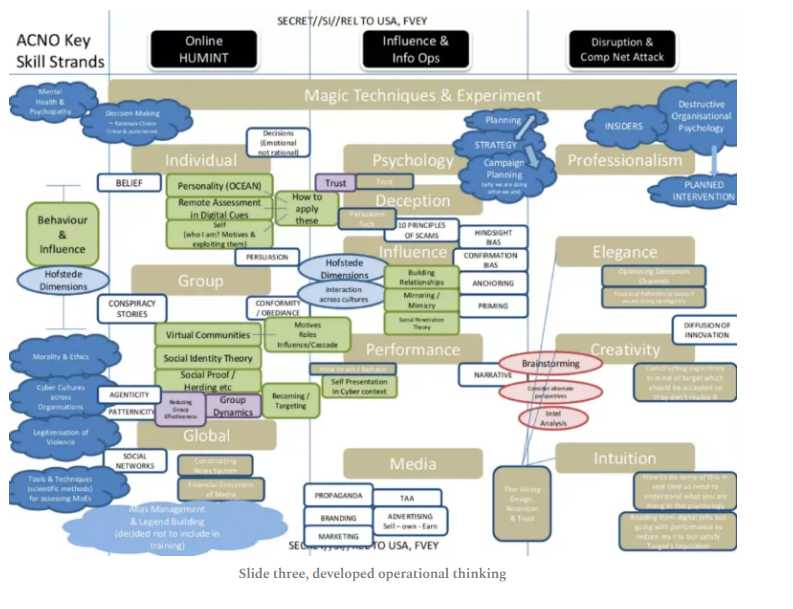
The third slide is perhaps the most damning of all, highlighting as it does the critical importance of having “insiders” in position to facilitate “destructive operational psychology” in support of “planned interventions.”
Again, this is a role ideal for a controlled asset such as Gonzalo Lira.
On April 30, 2022—some two weeks after he was released by the SBU—Lira started up his new YouTube channel, “The Roundtable,” using a “nine-year old Mac” computer—the social media infrastructure he used to rely upon was still in the custody of the SBU. His stated objective was to keep posting material “until I get arrested again.”
Lira’s “Roundtable” forums were a literal petri dish for the creation and collection of invaluable data for the kind of “Hofstede Dimension” analysis carried out by persons conducting information operations. I’ve watched a dozen or more of Lira’s “Roundtable” forums. Lira is an artful conductor, leading his guests through an emotional roller coaster of provocative positions on a variety of issues, making common cause in what is a textbook example of group bonding. Lira assumed the role of the brave dissident, continuing to post critical content with the help of like-minded guests.
Lira’s “Roundtable” podcast provided a platform for alternative media personalities such as Mark Sleboda, Brian Berletic, Alexander Mercouris and Alexander Christoforou from The Duran, Larry Johnson, and a host of others. One thing all these guests have in common, beyond their critical appraisal of Ukraine, is that all believe that Gonzalo Lira cannot be an asset of the SBU. In short, they reject out of hand any notion that the SBU could have recruited him following his arrest back in April 2022.
Mark Sleboda found the notion of Lira having been turned by the SBU “baseless, absurd, and puerile slander.” Brian Bertelic, Alexander Christoforou, and Alexander Mercouris’ all found the notion of Gonzalo Lira being recruited—or even recruitable—by the SBU “crazy.” Frankly speaking, I don’t take too much umbrage at their objections—none of them are intelligence professionals (although Alexander Mercouris, as a former senior barrister, should be well-acquainted with the concept of Police Confidential Informants).
Larry Johnson, however, is an intelligent professional. He has called my contention that Lira is an SBU asset “utter nonsense.” According to Johnson, “No CIA case officer in their right mind would sign up someone like Gonzalo for several reasons. First, he is an American citizen. CIA is prohibited from recruiting US citizens as intelligence assets. Second, Gonzalo’s commentary, analysis and hosted roundtables did not in any way advance a US Government position. Just the opposite — he was (and is) a strong critic.”
This line of thinking is nonsensical. First and foremost, there is no discussion of Lira being recruited by the CIA—that entire argument is a red herring. Second, it is Lira’s “commentary, analysis and hosted roundtables” which make him the ideal candidate for recruitment by the SBU. The JTRIG, in outlining its approach to conducting information operations, emphasized the importance of creating aliases for the purpose of infiltrating online forums such as Lira’s “Roundtable.” With Lira, the need to create an alias was eliminated—the SBU was now, literally, running the show.
All Lira had to do was what he always did—guide a discussion involving like-minded people. The SBU then could pick the topics, have Lira ask some leading questions, stroke some egos, emphasize certain points while downplaying others, and the “Roundtable” became a laboratory for human behavior ideal for the collection of data suitable for “Hofstede Dimension” analysis.
As Larry knows only too well, this kind of recruitment occurs all the time in the intelligence business. The way the CIA and MI-6 avoid the pitfalls associated with unpredictable characters like Gonzalo Lira is to have a partner intelligence service do the actual recruiting and running of an asset, while the CIA and MI-6 monitor and advise.
When I was with UNSCOM, I was involved in several human recruitments of this nature. Perhaps the most relevant was the recruitment of a Romanian aeronautical engineer who was trying to sell surface-to-surface missile production equipment to Iraq in violation of Security Council sanctions.
The British and Israeli intelligence services were both monitoring the preparations being made by Iraq to send a delegation to Romania. Based upon this information, the Romanian aeronautical engineer—who had been engaged in numerous illicit activities involving theft of government property and black-market sales of sensitive military technology—was selected as the best candidate for recruitment. After detailed planning on the part of all parties to this effort, a concept of operations was developed, and a timeline of action created.
The Romanian engineer was confronted by Romanian security officers with evidence of his illegal activities and given the option of going to jail or working for the Romanian intelligence service. By controlling the engineer, MI-6, through the Romanians, was able to manage every aspect of the meetings between the Iraqis and Romanians, including where the meeting would take place (so it could be monitored with video and audio recordings), and when it would take place. By turning the Romanian engineer, into a police confidential informant, MI-6 was able to shape the visit of the Iraqi delegation to conform with the timeline of desired outcomes all the while collecting all the desired intelligence necessary to achieve the overall operational objectives.
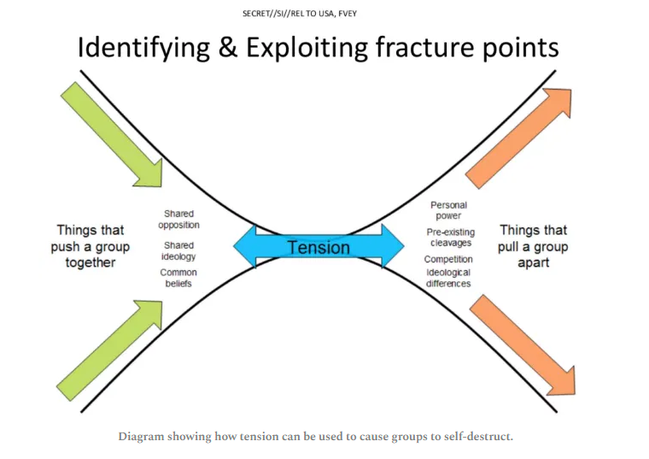
By controlling Gonzalo Lira, the SBU was able to do the same thing. The best example of how this is done, and for what purpose, can be found in one of the JTRIG training slides. One of the best “events” that a side conducting information operations can arrange is to have opposing groups engage in self-destructive behavior. To accomplish this, the SBU would need to be able to identify the factors that push a group together, and those which pull a group apart. Then the SBU would need to create tension by setting members against members using fracture points in the structure of the group that had been identified during the intelligence collection phase of the effort.
Based upon this model, one might reasonably conclude that the current tension between myself and like-minded persons in the alternative media universe, and Larry Johnson, Brian Bertelic, The Duran, and others, regarding whether or not Gonzalo Lira was an SBU asset was, in fact, a successful information operation “event” planned by the SBU to drive a wedge between like-minded individuals who were of a like mind when it comes to Russia’s ongoing conflict with Ukraine.
It was an event which began back in June 2022, when Gonzalo Lira published a video on YouTube in which he attacked me personally. It was an interesting video, one which seemed derived from the kind of behavioral science that drives the JTRIG and SBU methodologies regarding human network disruption. Lira pushed every button imaginable, clearly trying to trigger a response from me. While I was not immune to his attacks, I quickly recognized that Lira had fallen under the control of the SBU, and publicly called him out as such.
In retrospect, my reaction was predictable—like Pavlov’s Dog, I responded to appropriate stimuli. The split between myself and Lira, which continues to this day, appears to be the goal of an SBU information operation “event” on the grounds that anything which weakens the bonds of cooperation between members of the alternative media community can only be seen as a good thing by the SBU.
People often point out that Gonzalo Lira has not been found guilty of any wrongdoing by a system of reputable justice, and as such should not be condemned of a crime he may not have committed. But this ignores the reality that we are at war. If Gonzalo Lira’s behavior raises red flags—and no rational person can look at the details surrounding Lira’s April 2022 “catch and release” escapade without their being significant questions—then as combatants in this conflict, my fellow alternative media members and I would do well to treat all interaction with Mr. Lira—past, present, and future—with extreme caution.
At a minimum, the Gonzalo Lira saga has demonstrated that the alternative media community has great uncertainty about who Mr. Lira is, and where his allegiance ultimately falls. We have been blinded by our own egos, which benefited from Mr. Lira’s attention, which means in many ways we do not even know ourselves. Unless we collectively become wise to the reality of the situation, we are on a path toward losing the information war which, in our case, means the end of free and critical speech and thought.
I have been honest and open about my feelings regarding Gonzalo Lira. I also recognize that my actions were probably incited by Lira, in collaboration with the SBU, to achieve this very result. But at least I am willing to confront this matter straight on, respectful of both the facts and the circumstances.
Who among my critics can honestly say the same thing?
We are at war.
When viewed in this light, Gonzalo Lira is not a simple wayward US citizen with misplaced notions of protected speech in a hostile country which operates outside of the protections afforded by the US Constitution, but rather a collaborator trying to bring harm to our collective embrace of fact-based truth.
We are at war.
“Know the enemy and know yourself,” Sun Tzu wrote, lest you “fear the result of a hundred battles.” However, “If you know neither the enemy nor yourself, you will succumb in every battle.”
It is high time for the alternative media collective to start learning.
About themselves.
About their enemies.
Otherwise, we will fail in our mission of providing an alternative to the mainstream narrative.
We are at war.
Start acting like it.


















